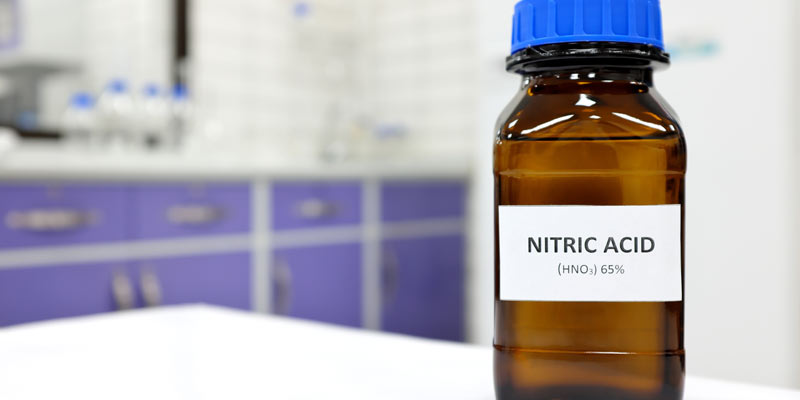How To Use Nitric Acid Safely
Nitric acid is a corrosive chemical and harmful to humans. Its contact with skin and eyes can cause serious burns. Affected skin will require flushing with soap and lukewarm water for at least 30 minutes. If strong concentrations of gas or solution penetrate clothing, remove immediately and seek appropriate medical attention. Adding nitric acid to the water and other chemicals can cause violent explosions. Always add nitric acid to the water rather than the other way around. Such mixing should always be done slowly and with reasonable care avoiding spattering or surface boiling of the solution. Personal protective equipment is needed before unscrewing the cap of the bottle having concentrated acid in the laboratory, at your workplace, or in your home. Safety glasses, a face shield for splash protection, gloves, and a vapor respirator are commonly required. An added safety precaution is eyewash stations and washing facilities within arm’s reach.
How To Store Nitric Acid
Store Concentrated nitric acid away from direct sunlight, other chemicals, and heat in a cool and dry area. Substances such as organic compounds, metals, alcohols, or moisture are incompatible with concentrated acid. Humidity of the environment needs to be maintained at a low level. Acid-resistant materials, such as glass containers, are recommended for storing concentrated acids. Use containers with tight caps and place them upright in safe cabinets. Concentrated acids and their solutions should be handled with care and stored on low shelves or in “Corrosives” cabinets.How To Dispose Of Nitric Acid
Never drain nitric acid directly into the sink or sewer. Routine cleaning with nitric acid often requires thorough washing with plenty of water. Spent acid should always be drained with thorough flushing. Segregate nitric acid waste from all other organic waste before disposal. It should be stored in secondary containers and marked as hazardous waste. Combination of nitric acid waste with any other waste streams could be dangerous and is a major cause of laboratory explosions. Before disposal, exposed parts of the body should be covered including eyes, face, hands, and clothes. Doors and windows must be opened to ensure good airflow before handling strong acid waste indoors. Dilution with water or simple neutralization with a base (e.g. caustic) ensures proper disposal of the concentrated acid.Become a Lab Alley Member and

RECEIVE exclusive offers, promotions, and discounts on chemicals.

Always have the product you need, when you need it with our AUTOSHIP program.

